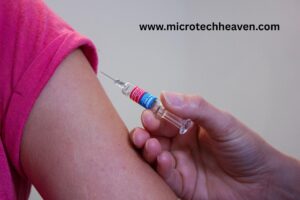Different Type of Vaccines : Vaccination Age Chart
Vaccinations are one of the most effective ways to protect your child from serious and potentially life-threatening diseases. Following a vaccination age chart ensures that your child receives the right vaccines at the right time, providing optimal protection as they grow5. This comprehensive guide will walk you through the essential vaccines for your baby and child, explaining why each one is important and when it should be administered.
Why Follow a Vaccination Schedule?
Imagine a tiny shield, invisible but incredibly strong, surrounding your child. That’s what vaccines do. They work by introducing a weakened or inactive form of a disease-causing organism to your child’s body5. This prompts the immune system to create antibodies, which are like tiny soldiers that recognize and fight off the disease if encountered in the future.
Timely vaccination is crucial because it ensures your child is protected when they are most vulnerable5. Babies and young children are particularly susceptible to severe complications from certain diseases, making early vaccination essential.
Understanding the Vaccination Age Chart
The vaccination age chart is a schedule recommended by health experts, like the CDC, outlining when children should receive specific vaccines7. This schedule is designed to provide the best protection based on a child’s age and risk factors.

Important Vaccines for Babies and Children
Here’s a detailed look at the most important vaccines your child will need, from birth through adolescence:
Hepatitis B (HepB)
- What it protects against:Hepatitis B is a serious liver infection caused by a virus3. It can lead to chronic liver disease, liver cancer, and even death.
- When it’s given:
Rotavirus (RV)
- What it protects against:Rotavirus is a common virus that causes severe diarrhea, vomiting, and dehydration, especially in infants and young children.
- When it’s given:
- First dose: 2 months
- Second dose: 4 months
- Third dose (if needed, depending on the brand): 6 months
Diphtheria, Tetanus, and Pertussis (DTaP)
- What it protects against:
- Diphtheria: A serious bacterial infection that affects the throat and nose.
- Tetanus: A bacterial infection that causes painful muscle stiffness and spasms.
- Pertussis (whooping cough): A highly contagious respiratory infection characterized by severe coughing fits.
- When it’s given:
Haemophilus influenzae type b (Hib)
- What it protects against:Hib is a bacteria that can cause serious infections, including meningitis (inflammation of the brain and spinal cord), pneumonia, and epiglottitis (a life-threatening infection of the throat).
- When it’s given:
Pneumococcal Conjugate Vaccine (PCV13)
- What it protects against:PCV13 protects against 13 types of pneumococcal bacteria, which can cause pneumonia, meningitis, and ear infections.
- When it’s given:
- First dose: 2 months
- Second dose: 4 months
- Third dose: 6 months
- Fourth dose: 12–15 months1
Inactivated Poliovirus Vaccine (IPV)
- What it protects against:Polio is a highly infectious viral disease that can cause paralysis and even death8.
- When it’s given:
- First dose: 2 months
- Second dose: 4 months
- Third dose: 6-18 months
- Booster dose: 4–6 years1
Measles, Mumps, and Rubella (MMR)
- What it protects against:
- Measles: A highly contagious viral infection that can cause fever, rash, cough, and serious complications like pneumonia and encephalitis (inflammation of the brain).
- Mumps: A viral infection that causes swelling of the salivary glands, fever, headache, and muscle aches. It can lead to complications like meningitis and deafness.
- Rubella (German measles): A viral infection that can cause mild symptoms but can be very dangerous for pregnant women, as it can cause serious birth defects.
- When it’s given:
Varicella (Chickenpox)
- What it protects against:Chickenpox is a highly contagious viral infection that causes an itchy rash with small, fluid-filled blisters.
- When it’s given:
Hepatitis A (HepA)
- What it protects against:Hepatitis A is a liver infection caused by a virus. It can cause fever, fatigue, nausea, vomiting, and jaundice (yellowing of the skin and eyes).
- When it’s given:
Meningococcal Conjugate Vaccine (MenACWY)
- What it protects against:Meningococcal disease is a serious bacterial infection that can cause meningitis and bloodstream infections.
- When it’s given:
Tetanus, Diphtheria, Pertussis (Tdap)
- What it protects against:This is a booster shot that provides continued protection against tetanus, diphtheria, and pertussis.
- When it’s given:
Human Papillomavirus (HPV)
- What it protects against:HPV is a common virus that can cause genital warts and certain types of cancer, including cervical, anal, and throat cancer.
- When it’s given:
Influenza (Flu)
- What it protects against:The flu is a contagious respiratory illness caused by influenza viruses.
- When it’s given:
- Annually, starting at 6 months of age3
COVID-19
- What it protects against:COVID-19 vaccination helps protect against the SARS-CoV-2 virus, preventing severe illness, hospitalization, and death2.
- When it’s given:

Addressing Common Concerns
- Safety:Vaccines are rigorously tested and monitored to ensure their safety and effectiveness5. Serious side effects are rare.
- Multiple Vaccines:Giving multiple vaccines at the same visit is safe and effective5. It reduces the number of visits required and protects your child sooner.
- Individualized Schedules:If your child has missed vaccines or has specific health conditions, your doctor can create an individualized vaccination schedule to ensure they receive the necessary protection.
Step-by-Step Guide to Following the Vaccination Age Chart
- Consult with Your Pediatrician:Your pediatrician is your best resource for understanding the vaccination age chart and creating a plan that’s right for your child.
- Keep a Record:Maintain a record of your child’s vaccinations. This will be helpful for school enrollment, travel, and future healthcare needs.
- Stay on Schedule:Adhere to the recommended schedule as closely as possible to ensure continuous protection.
- Ask Questions:Don’t hesitate to ask your pediatrician any questions or express any concerns you may have about vaccines.
Anecdotes: Real-Life Impact of Vaccines
Consider the story of Sarah, whose daughter Emily contracted measles before she was old enough to be vaccinated. Emily suffered severe complications, including pneumonia, and required hospitalization. Sarah now advocates for vaccination, sharing her story to highlight the importance of protecting children from preventable diseases.
Then there’s Mark, a father who diligently followed the vaccination age chart for his son, ensuring he received all recommended vaccines on time. When a measles outbreak occurred in their community, Mark’s son remained healthy, thanks to the protection provided by the MMR vaccine.
Transitioning to Confidence: Why You Can Trust Vaccines
Vaccines have transformed public health, eradicating or significantly reducing the incidence of many once-common and devastating diseases. The science behind vaccines is solid, and the benefits far outweigh the risks. By following the vaccination age chart, you’re giving your child the best possible chance to grow up healthy and strong.
Conclusion
Protecting your child’s health is a top priority, and vaccines are a powerful tool in achieving that goal. By understanding the vaccination age chart and adhering to the recommended schedule, you can ensure your child receives the necessary protection against preventable diseases. Talk to your pediatrician, stay informed, and take proactive steps to safeguard your child’s well-being.
Frequently Asked Questions (FAQs)
What are the most important vaccines for babies?
- The most important vaccines for babiesinclude HepB, RV, DTaP, Hib, PCV13, and IPV. These vaccines protect against serious diseases that can have severe consequences for infants.
How does the vaccination age chart help?
- The vaccination age chartprovides a timeline for when each vaccine should be administered, ensuring that children receive protection at the most vulnerable stages of their development.
Are vaccines safe for my child?
- Yes, vaccines are safe. They undergo rigorous testing and monitoring to ensure their safety and effectiveness. Serious side effects are rare.
What should I do if my child misses a vaccine?
- If your child misses a vaccine, talk to your pediatrician. They can help you create a catch-up schedule to ensure your child receives the necessary protection.



